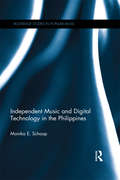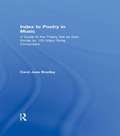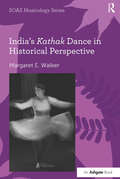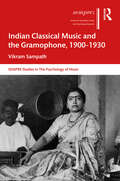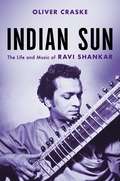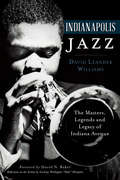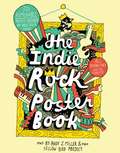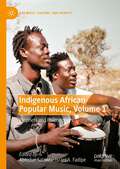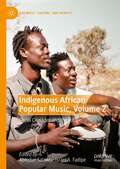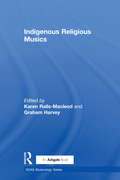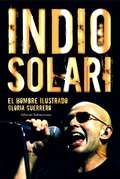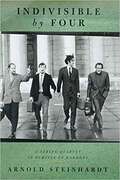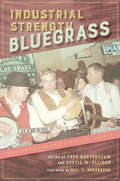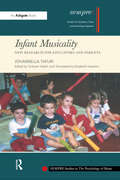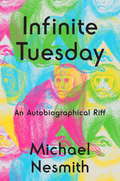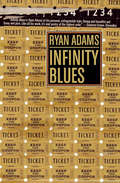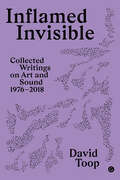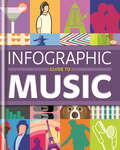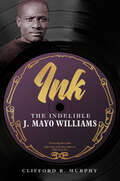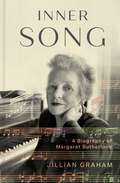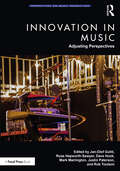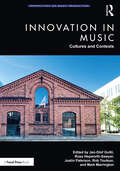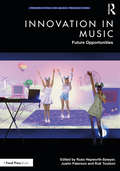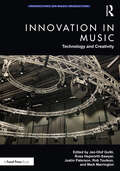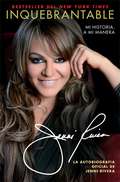- Table View
- List View
Independent Music and Digital Technology in the Philippines (Routledge Studies in Popular Music)
by Monika E. SchoopSince the turn of the century, the impact of digital technologies on the promotion, production and distribution of music in the Philippines has both enabled and necessitated an increase in independent musical practices. In the first in-depth investigation into the independent music scene in the Philippines, Monika E. Schoop exposes and portrays the as yet unexplored restructurings of the Philippine music industries, showing that digital technologies have played an ambivalent role in these developments. While they have given rise to new levels of piracy, they have also offered unprecedented opportunities for artists. The near collapse of the transnational recording industry in the Philippines stands in stark contrast to a thriving independent music scene in the county's national capital region, Metro Manila, which cuts across musical genres and whose members successfully adjust to a rapidly evolving industry scenario. Independent practices have been facilitated by increased access to broadband Internet, the popularity of social media platforms and home recording technology. At the same time, changing music industry structures often leave artists with no other option but to operate independently. Based on extensive fieldwork online and offline, the book explores the diverse and innovative music production, distribution, promotion and financing strategies that have become constitutive of the independent music scene in twenty-first-century Manila.
Index to Poetry in Music
by Carol June BradleyFirst Published in 2003. Routledge is an imprint of Taylor & Francis, an informa company.
India's Kathak Dance in Historical Perspective (SOAS Studies in Music)
by Margaret E. WalkerKathak, the classical dance of North India, combines virtuosic footwork and dazzling spins with subtle pantomime and soft gestures. As a global practice and one of India's cultural markers, kathak dance is often presented as heir to an ancient Hindu devotional tradition in which men called Kathakas danced and told stories in temples. The dance's repertoire and movement vocabulary, however, tell a different story of syncretic origins and hybrid history - it is a dance that is both Muslim and Hindu, both devotional and entertaining, and both male and female. Kathak's multiple roots can be found in rural theatre, embodied rhythmic repertoire, and courtesan performance practice, and its history is inextricable from the history of empire, colonialism, and independence in India. Through an analysis both broad and deep of primary and secondary sources, ethnography, iconography and current performance practice, Margaret Walker undertakes a critical approach to the history of kathak dance and presents new data about hereditary performing artists, gendered contexts and practices, and postcolonial cultural reclamation. The account that emerges places kathak and the Kathaks firmly into the living context of North Indian performing arts.
Indian Classical Music and the Gramophone, 1900–1930 (SEMPRE Studies in The Psychology of Music)
by Vikram SampathIn 1902 The Gramophone Company in London sent out recording experts on "expeditions" across the world to record voices from different cultures and backgrounds. All over India, it was women who embraced the challenge of overcoming numerous social taboos and aesthetic handicaps that came along with this nascent technology. Women who took the plunge and recorded largely belonged to the courtesan community, called tawaifs and devadasis, in North and South India, respectively. Recording brought with it great fame, brand recognition, freedom from exploitative patrons, and monetary benefits to the women singers. They were to become pioneers of the music industry in the Indian sub-continent. However, despite the pioneering role played by these women, their stories have largely been forgotten. Contemporaneous with the courtesan women adapting to recording technology was the anti-nautch campaign that sought to abolish these women from the performing space and brand them as common prostitutes. A vigorous renaissance and arts revival movement followed, leading to the creation of a new classical paradigm in both North Indian (Hindustani) and South Indian (Carnatic) classical music. This resulted in the standardization, universalization, and institutionalization of Indian classical music. This newly created classical paradigm impacted future recordings of The Gramophone Company in terms of a shift in genres and styles. Vikram Sampath sheds light on the role and impact of The Gramophone Company’s early recording expeditions on Indian classical music by examining the phenomenon through a sociocultural, historical and musical lens. The book features the indefatigable stories of the women and their experiences in adapting to recording technology. The artists from across India featured are: Gauhar Jaan of Calcutta, Janki Bai of Allahabad, Zohra Bai of Agra, Malka Jaan of Agra, Salem Godavari, Bangalore Nagarathnamma, Coimbatore Thayi, Dhanakoti of Kanchipuram, Bai Sundarabai of Pune, and Husna Jaan of Banaras.
Indian Sun: The Life and Music of Ravi Shankar
by Oliver CraskeThe definitive biography of Ravi Shankar, one of the most influential musicians and composers of the twentieth century, told with the cooperation of his estate, family, and friendsFor over eight decades, Ravi Shankar was India's greatest cultural ambassador. He was a groundbreaking performer and composer of Indian classical music, who brought the music and rich culture of India to the world's leading concert halls and festivals, charting the map for those who followed in his footsteps. Renowned for playing Monterey Pop, Woodstock, and the Concert for Bangladesh--and for teaching George Harrison of The Beatles how to play the sitar--Shankar reshaped the musical landscape of the 1960s across pop, jazz, and classical music, and composed unforgettable scores for movies like Pather Panchali and Gandhi.In Indian Sun: The Life and Music of Ravi Shankar, writer Oliver Craske presents readers with the first full portrait of this legendary figure, revealing the personal and professional story of a musician who influenced--and continues to influence--countless artists. Craske paints a vivid picture of a captivating, restless workaholic--from his lonely and traumatic childhood in Varanasi to his youthful stardom in his brother's dance troupe, from his intensive study of the sitar to his revival of India's national music scene. Shankar's musical influence spread across both genres and generations, and he developed close friendships with John Coltrane, Philip Glass, Yehudi Menuhin, George Harrison, and Benjamin Britten, among many others. For ninety-two years, Shankar lived an endlessly colorful and creative life, a life defined by musical, emotional, and spiritual quests--and his legacy lives on.Benefiting from unprecedented access to Shankar's archives, and drawing on new interviews with over 130 subjects--including his second wife and both of his daughters, Norah Jones and Anoushka Shankar--Indian Sun gives readers unparalleled insight into a man who transformed modern music as we know it today.
Indianapolis Jazz: The Masters, Legends and Legacy of Indiana Avenue (Music Ser.)
by David N. Baker David Leander WilliamsGet into the music with David Leander Williams as he charts the rise and fall of Indiana Avenue, the Majestic Entertainment Boulevard of Indianapolis, which produced some of the nation's most influential jazz artists. The performance venues that once lined the vibrant thoroughfare were an important stop on the Chitlin' Circuit and provided platforms for greats like Freddie Hubbard and Jimmy Coe. Through this biography of the bustling street, meet scores of the other musicians who came to prominence in the avenue's heyday, including trombonist J.J. Johnson and guitarist Wes Montgomery, as well as songwriters like Noble Sissle and Leroy Carr.
Indie Rock Poster Book
by Yellow Bird Project Andy J. MillerFrom the authors of the popular Indie Rock Coloring Book, this poster book is a colorful celebration of indie rock music and art. Showcasing original artwork by thirty of today's cutting-edge illustrators--including Mike Perry, Deanne Cheuk, Jeremyville, Andy J. Miller, and more--this poster collection is inspired by classic indie rock songs of each artist's choosing. Featuring such favorite indie rock acts as the Bon Iver, Devendra Banhart, and Iron & Wine, this book is a must-have for indie art and music fans. Plus, it's all for a good cause: royalties go to the host of admirable charities supported by Yellow Bird Project.
Indigenous African Popular Music, Volume 1: Prophets and Philosophers (Pop Music, Culture and Identity)
by Abiodun Salawu Israel A. FadipeThis volume explores the nature, philosophies and genres of indigenous African popular music, focusing on how indigenous African popular music artistes are seen as prophets and philosophers, and how indigenous African popular music depicts the world. Indigenous African popular music has long been under-appreciated in communication scholarship. However, understanding the nature and philosophies of indigenous African popular music reveals an untapped diversity which only be unraveled by knowledge of the myriad cultural backgrounds from which its genres originate. Indigenous African popular musicians have become repositories of indigenous cultural traditions and cosmologies.With a particular focus on scholarship from Nigeria, Zimbabwe and South Africa, this volume explores the work of these pioneering artists and their protégés who are resiliently sustaining, recreating and popularising indigenous popular music in their respective African communities, and at the same time propagating the communal views about African philosophies and the temporal and spiritual worlds in which they exist.
Indigenous African Popular Music, Volume 2: Social Crusades and the Future (Pop Music, Culture and Identity)
by Abiodun Salawu Israel A. FadipeThis volume examines how African indigenous popular music is deployed in democracy, politics and for social crusades by African artists. Exploring the role of indigenous African popular music in environmental health communication and gender empowerment, it subsequently focuses on how the music portrays the African future, its use by African youths, and how it is affected by advanced broadcast technologies and the digital media. Indigenous African popular music has long been under-appreciated in communication scholarship. However, understanding the nature and philosophies of indigenous African popular music reveals an untapped diversity which can only be unraveled by the knowledge of myriad cultural backgrounds from which its genres originate. With a particular focus on scholarship from Nigeria, Zimbabwe and South Africa, this volume explores how, during the colonial period and post-independence dispensation, indigenous African music genres and their artists were mainstreamed in order to tackle emerging issues, to sensitise Africans about the affairs of their respective nations and to warn African leaders who have failed and are failing African citizenry about the plight of the people. At the same time, indigenous African popular music genres have served as a beacon to the teeming African youths to express their dreams, frustrations about their environments and to represent themselves. This volume explores how, through the advent of new media technologies, indigenous African popular musicians have been working relentlessly for indigenous production, becoming champions of good governance, marginalised population, and repositories of indigenous cultural traditions and cosmologies.
Indigenous Religious Musics (Soas Studies In Music Ser.)
by Graham Harvey Karen Ralls-MacLeodCelebrating the diversity of indigenous nations, cultures and religions, the essays which comprise this volume discuss the musics performed by a wide variety of peoples as an integral part of their cultural traditions. These include examinations of the various styles of Maori, Inuit and Australian Aboriginal musics, and the role of music in Korean Shaman rituals. Indeed, music forms a key component of many such rituals and belief systems and examples of these are explored amongst the peoples of Uganda, Amazonia and Africa. Through analysis of these rituals and the part music plays in them, the essays also open up further themes including social groupings and gender divisions, and engage with issues and debates on how we define and approach the study of indigeneity, religiosity and music. With downloadable resources featuring some of the music discussed in the book and further information on other available recordings, this is a book which gives readers the opportunity to gain a richer experience of the lived realities of indigenous religious musics.
Indio Solari: El hombre ilustrado
by Gloria GuerreroPocos personajes surgidos de la música popular ofrecen tantos aspectosdestacables como el Indio Solari, ex líder de Patricio Rey y susredonditos de ricota. Él inventó formas de defensa y ataque a las fortalezas convencionales dela estupidez, abrió nuevos caminos, difundió una lírica propia queconvoca a montones de admiradores de distintas generaciones. Elindividuo conocido como el Indio Solari sigue siendo un misterio.Escrito con una precisión acorde con el ritmo y modo en que la voz delIndio se ajusta a sus canciones, es el mejor homenaje al iluminadoadalid del rock argentino, la recompensa más justa que pueden recibiruna actividad y una actitud determinantes en la sociedad y la cultura.Un libro serio, con el suspenso narrativo de una novela, que se lee y seoye como un reclamo ricotero insoslayable.
Indivisible By Four: A String Quartet In Pursuit Of Harmony
by Arnold SteinhardtThe Guarneri Quartet is fabled for its unique longevity and high-spirited virtuosity. Here is its story from the inside--a story filled with drama, humor, danger, compassion, and, of course, glorious music. A player who studies and performs the exalted string-quartet repertoire has opted for a very special life. Arnold Steinhardt, tracing his own development as a student, orchestra player, and budding young soloist, gives a touching account of how he and his intrepid colleagues were converted to chamber music despite the daunting odds against success. And he reveals, as no one has before, the intensely difficult process by which--on the battlefield of daily three-hour rehearsals--four individualists master and then overcome the confining demands of ensemble playing.
Industrial Strength Bluegrass: Southwestern Ohio's Musical Legacy (Music in American Life)
by Fred Bartenstein Curtis W. Ell isonIn the twentieth century, Appalachian migrants seeking economic opportunities relocated to southwestern Ohio, bringing their music with them. Between 1947 and 1989, they created an internationally renowned capital for the thriving bluegrass music genre, centered on the industrial region of Cincinnati, Dayton, Hamilton, Middletown, and Springfield. Fred Bartenstein and Curtis W. Ellison edit a collection of eyewitness narratives and in-depth analyses that explore southwestern Ohio’s bluegrass musicians, radio broadcasters, recording studios, record labels, and performance venues, along with the music’s contributions to religious activities, community development, and public education. As the bluegrass scene grew, southwestern Ohio's distinctive sounds reached new fans and influenced those everywhere who continue to play, produce, and love roots music. Revelatory and multifaceted, Industrial Strength Bluegrass shares the inspiring story of a bluegrass hotbed and the people who created it. Contributors: Fred Bartenstein, Curtis W. Ellison, Jon Hartley Fox, Rick Good, Lily Isaacs, Ben Krakauer, Mac McDivitt, Nathan McGee, Daniel Mullins, Joe Mullins, Larry Nager, Phillip J. Obermiller, Bobby Osborne, and Neil V. Rosenberg.
Infant Musicality: New Research for Educators and Parents (Sempre Studies In The Psychology Of Music Ser.)
by Johannella TafuriWhat can infants hear? What are their reactions to music? Is it useful for them to sing and listen to music? Is their auditory sensitivity developed before their birth? At what age do they start singing, and clapping their hands? How can their musical development be improved? These (and other) questions are present in today's debate on music education and the responses are normally given in an intuitive way. It is now necessary and urgent to sketch a developmental profile of infants, starting from their earliest manifestations. In the last 30 years, research in this field has been progressively developed. In most cases research has been devoted to single aspects of more complex problems. Moreover, it has been based on non-homogeneous categories of subjects and by different methods. Motivated by the fact that many open problems need to be solved, Professor Tafuri decided, in 1998, to begin a longitudinal research project devoted to studying the musical development in children from 0 to 6 years, with particular attention on the ability to sing in tune. During these 6 years, the children would have a regular music education experience with their mothers and often other members of the immediate family. This book has two main areas of focus. The first reconstructs the development of human musical abilities. Tafuri systematically reports studies of the development of vocal, rhythmic and motor abilities through the observation of the same participants for three years, beginning with the mothers' experiences in the last three months of pre-natal life. The programme of musical activities and the modalities of the collaboration with the parents are described. The second area of focus puts forward an educational perspective based on the results of the research. The amount and the quality of the collected data can allow parents and educators to plan different activities by considering the starting point for individual participants and the development of the
Infinite Tuesday: An Autobiographical Riff
by Michael NesmithMichael Nesmith’s eclectic, electric life spans his star-making role on The Monkees, his invention of the music video, and his critical contributions to movies, comedy, and the world of virtual reality. Above all, his is a seeker’s story, a pilgrimage in search of a set of principles to live by. That search took Nesmith from a childhood in Dallas, where his single mother Bette invented Liquid Paper, to the set of The Monkees in Los Angeles; to the heart of swinging London with John Lennon and Jimi Hendrix; and to an unexpected oasis of brilliance in the Santa Fe desert, where his friendships with Douglas Adams and Los Alamos scientists would point him toward the power of the infinite and the endless possibilities of human connection. This funny, thoughtful, self-aware book is a window onto an unexpected life, inflected at every turn by the surprising candor and absurdist humor of an American original. Opening Infinite Tuesday is like stepping into the world of Michael Nesmith, where something curious is always unfolding, and where riffs on everything from bands to dogs to the nature of reality make for an endlessly engaging journey.
Infinity Blues
by Ryan Adams&“A passionate, arresting, and entertaining book of verse . . . The images are vivid and the voice is honest and powerful&” (Stephen King). This is the debut collection of poetry by singer/songwriter Ryan Adams, acclaimed for albums including Cardinology, Cold Roses, and Prisoner. His work in this volume rings with emotional authenticity—and provides perhaps an even deeper insight into the man than is revealed through the songs that have resonated with fans the world over. &“Ryan Adams writes with equal parts precision and recklessness; the blood he draws from the text is easily as unnerving as its unapologetic tenderness. He is proof that poetry will find its writer.&” —Mary-Louise Parker &“Infinity Blues is Ryan Adams at his personal, unforgettable best. Strong and beautiful and funny and pure. Like all his work, it&’s soul poetry of the highest order.&” —Cameron Crowe &“This is much better than reading a friend&’s journal. It&’s more like watching somebody you love in the bathtub talking to himself. You&’re like, wow, he&’s even good at taking a bath. After reading Infinity Blues (which I think is a great title), I give Ryan Adams the best compliment I ever got—and the only reason for reading anyone&’s poetry. Ryan, I really like your mind.&” —Eileen Myles
Inflamed Invisible: Collected Writings on Art and Sound, 1976-2018 (Goldsmiths Press / Sonics Series #2)
by David ToopA rich collection of essays tracing the relationship between art and sound. In the 1970s David Toop became preoccupied with the possibility that music was no longer bounded by formalities of audience: the clapping, the booing, the short attention span, the demand for instant gratification. Considering sound and listening as foundational practices in themselves leads music into a thrilling new territory: stretched time, wilderness, video monitors, singing sculptures, weather, meditations, vibration and the interior resonance of objects, interspecies communications, instructional texts, silent actions, and performance art. Toop sought to document the originality and unfamiliarity of this work from his perspective as a practitioner and writer. The challenge was to do so without being drawn back into the domain of music while still acknowledging the vitality and hybridity of twentieth-century musics as they moved toward art galleries, museums, and site-specificity. Toop focused on practitioners, whose stories are as compelling as the theoretical and abstract implications of their works.Inflamed Invisible collects more than four decades of David Toop's essays, reviews, interviews, and experimental texts, drawing us into the company of artists and their concerns, not forgetting the quieter, unsung voices. The volume is an offering, an exploration of strata of sound that are the crossing points of sensory, intellectual, and philosophical preoccupations, layers through which objects, thoughts and air itself come alive as the inflamed invisible.
Infographic Guide to Music (Infographic Guides)
by Graham BettsOver 80 stunning, ingenious and absorbing music infographics! Infographic Guide to Music presents unique, witty and surprising facts about every music genre, from pop, rock, indie, house, dance, electronic, rap, country and classical. Mixing musical stats with facts on all your favourite leading legends, it features infamous and often ludicrous tales of the music business.More than just a book of words, with graphs, Venn diagrams and charts, this book provides a unique overview of the music world, boasting over 100 original artworks and illustrations and at-a-glance facts to amaze and astound readers.
Ink: The Indelible J. Mayo Williams (Music in American Life)
by Clifford R. MurphyThe product of a hardscrabble childhood, J. Mayo “Ink” Williams parlayed an Ivy League education into unlikely twin careers as a foundational producer of Black music and pioneering Black player in the early NFL. Clifford R. Murphy tells the story of an ambitious, upwardly mobile life affected, but never daunted, by white society’s racism or the Black community’s class tensions. Williams caroused with Paul Robeson, recorded the likes of Ma Rainey and Blind Lemon Jefferson, and lined up against Chicago Bears player-coach George Halas. Though resented by the artists he exploited, Williams combined a rock-solid instinct for what would sell with an ear for music that put him at the forefront of finding, recording, and blending blues and jazz. Murphy charts Williams’s wide-ranging accomplishments while providing portraits of the cutthroat recording industry and the possibilities, however constrained, of Black life in the 1920s and 1930s. Vivid and engaging, Ink brings to light the extraordinary journey of a Black businessman and athlete.
Inner Song: A Biography of Margaret Sutherland
by Jillian GrahamMargaret Sutherland was one of the most innovative and influential Australian composers. In the first half of the twentieth century, her desire to be both serious composer and mother was atypical, and she faced significant challenges - public and private - in blending these roles. Against the backdrop of an unhappy and unsupportive marriage and a society not yet ready to accept her creative ambitions and strong views on Australia's musical development, she remained admirably steadfast in pursuing her goals. Sutherland created over two hundred compositions, ceaselessly campaigned on behalf of Australian music and musicians, and led the initial push to construct what is now Arts Centre Melbourne. In her attempts to redefine beauty in music she used idiosyncratic musical language, being at the mercy of 'sound pictures' and 'floating ideas'. This book tells her remarkable story, laying bare something of Sutherland's inspiring 'inner song'.
Innovation in Music: Adjusting Perspectives (Perspectives on Music Production)
by Russ Hepworth-Sawyer Mark Marrington Justin Paterson Rob Toulson Jan-Olof Gullö Dave HookInnovation in Music: Adjusting Perspectives brings together cutting-edge research on new innovations in the field of music production, technology, performance, and business. With contributions from a host of well-respected researchers and practitioners, this volume provides crucial coverage on the relationship between innovation and rebellion.Including chapters on generative AI, gender equality, live music, quantisation, and composition, this book is recommended reading for music industry researchers working in a range of fields, as well as professionals interested in industry innovations.
Innovation in Music: Cultures and Contexts (ISSN)
by Russ Hepworth-Sawyer Mark Marrington Justin Paterson Rob Toulson Jan-Olof GullöInnovation in Music: Cultures and Contexts is a groundbreaking collection bringing together contributions from instructors, researchers, and professionals. Split into two sections, covering creative production practices and national/international perspectives, this volume offers truly global outlooks on ever-evolving practices.Including chapters on Dolby Atmos, the history of distortion, creativity in the pandemic, and remote music collaboration, this is recommended reading for professionals, students, and researchers looking for global insights into the fields of music production, music business, and music technology.
Innovation in Music: Future Opportunities (Perspectives on Music Production)
by Russ Hepworth-SawyerInnovation in Music: Future Opportunities brings together cutting-edge research on new innovations in the field of music production, technology, performance and business. Including contributions from a host of well-respected researchers and practitioners, this volume provides crucial coverage on a range of topics from cybersecurity, to accessible music technology, performance techniques and the role of talent shows within music business. Innovation in Music: Future Opportunities is the perfect companion for professionals and researchers alike with an interest in the music industry.
Innovation in Music: Technology and Creativity (ISSN)
by Russ Hepworth-Sawyer Mark Marrington Justin Paterson Rob Toulson Jan-Olof GullöInnovation in Music: Technology and Creativity is a groundbreaking collection bringing together contributions from instructors, researchers, and professionals. Split into two sections, covering composition and performance, and technology and innovation, this volume offers truly international perspectives on ever-evolving practices.Including chapters on audience interaction, dynamic music methods, AI, and live electronic performances, this is recommended reading for professionals, students, and researchers looking for global insights into the fields of music production, music business, and music technology.
Inquebrantable
by Jenni RiveraLa única autobiografía autorizada de Jenni Rivera Jenni Rivera es la talentosa y aclamada cantante méxico-americana de música norteña, conocida como La Diva de la Banda, que falleció en un accidente aéreo el 9 de diciembre de 2012. Jenni había estado escribiendo su autobiografía, Inquebrantable, durante algunos años.Jenni Rivera fue madre de cinco hijos, abuela de tres nietos, cantante, compositora, actriz, productora de televisión, protagonista del show de televisión I Love Jenny y empresaria. Su vida estuvo llena de tragedias, problemas personales, perseverancia y éxito. Se convirtió en la cantante de música en español de mayor éxito en Estados Unidos con ventas récord de más de 15 millones de CDs. La vida personal de Jenni siempre estuvo en el centro de muchas historias en los medios de comunicación que expusieron su vida no tan perfecta. A Jenni la caracterizó la franqueza con la que hablaba de sus problemas personales y que la ayudó a formar un vínculo inquebrantable de confianza con sus fans. Como consecuencia, Jenni se convirtió en una figura de fortaleza y una fuente de inspiración para todas las mujeres. Inquebrantable es la única autobiografía autorizada por la familia de la cantante. En ella Jenni revive los momentos más cruciales de su vida y dificultades que nunca discutió públicamente. Jenni habla sobre sus experiencia de violencia doméstica, abuso sexual, sus divorcios, problemas de imagen personal por su peso, sus triunfos en una industria dominada por los hombres y cómo crió a sus cinco hijos como una madre soltera. En su libro, Jenni nos demuestra que nunca dejó de ser la Rivera rebelde de Long Beach, la joven que nunca perdía su sentido del humor, su positivismo y su espíritu luchador. "Son cosas muy fuertes las que han pasado en mi vida. No puedo enfocarme en lo negativo; eso te derrota, te destruye. Soy una mujer como cualquier otra. Las veces que me he caído me he levantado". --Jenni Rivera
